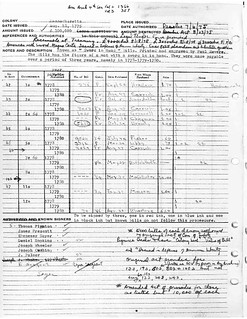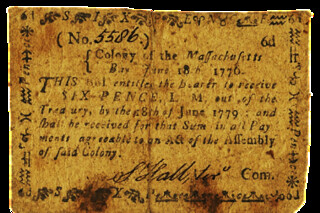
PREV ARTICLE
NEXT ARTICLE
FULL ISSUE
PREV FULL ISSUE
HARLEY FREEMAN COLONIAL PAPER MONEY INVENTORYThe Summer 2017 issue of The C4 Newsletter (C4N) (published by the Colonial Coin Collectors Club) has an important article by Stuart Hanebuth on the provenance of many
colonial-era notes from the Eric P. Newman collection. With permission, we are republishing it here. Thanks to editor Will Nipper for providing the text and images. -Editor
Colonial Paper Money Collectors Inventory Includes Provenances Back to Chapman (Stuart Hanebuth)
Figure 1 - A Page from the Harley L. Freeman Inventory of Colonial and Continental Currency Harley Freeman was a collector who lived from 1895 to 1976. Mr. Freeman lived in Cleveland, Ohio until 1947 when he retired to Florida. Freeman began collecting coins as a child and was active in the ANA where he was chairman of the board in 1933 and was a charter member of the Western Reserve Numismatic Society. Mr. Freeman was also founder and president of the Daytona Beach Numismatic Club. He assembled a collection of Colonial and Continental paper money in a class with legendary collections like Henry Chapman, Joshua Cohen, F.C.C. Boyd and John Ford. The Freeman collection was acquired Eric Newman in the 1960’s. The inventory in the Freeman Journal tracks many colonial and Continental bills in the Freeman Collection back to the great collections of Henry Chapman, Joshua Cohen, T. James Clarke, Wayte Raymond and many others. It also contains a comprehensive listing, by emission and denomination, of bills that are housed in over a dozen museum collections. Some of Freeman’s purchase prices are coded using the letters: A,C,H,J,N,O, R, S, T,U and Y. Analysis of the inventory suggests that the code, in part, was as follows: R – 1; S – 2; T – 3; U – 4; Y – 5, ? – 6; A – 7; 8 – ?; 9 – ? C, H, J and O are Unassigned/Unknown Given the data, it is difficult to speculate as to the assignment of C,H,J and O. While somewhat trivial, understanding the cost basis for Freeman’s acquisitions provides insights into the history of collecting colonial bills. Newman acquired the Freeman Collection and many of the bills which have appeared in the recent Newman Auctions are listed in Freeman’s inventory. Bills in Freeman’s collection contain information on the purchase price, date acquired and the source of the acquisition.
Figure 2 – (Right) A Six Pence bill form the Massachusetts June 18 , 1776 emission. This bill, recently sold in the Newman Auctions, was purchased from Chapman by Freeman for $0.75. (Below) A Page from the Harley L. Freeman Inventory recording its seller and purchase price.  PCGS Currency has confirmed that they will recognize the provenances in the Freeman Journal when grading colonial bills, allowing this bill to appear in a holder that includes the Chapman provenance. The Freeman Inventory is one of the most important works in colonial paper money. It provides valuable population data, as well as insights into the history of the vast Newman collection currently at auction. Understanding how the pieces in our collections have traveled through time is as important as understanding their contemporaneous importance. Thanks to the work of the Newman Foundation collectors can appreciate that history now, and for time to come. For more information on the Colonial Coin Collectors Club, see:  Wayne Homren, Editor The Numismatic Bibliomania Society is a non-profit organization promoting numismatic literature. See our web site at coinbooks.org. To submit items for publication in The E-Sylum, write to the Editor at this address: whomren@gmail.com To subscribe go to: https://my.binhost.com/lists/listinfo/esylum All Rights Reserved. NBS Home Page Contact the NBS webmaster 
|

